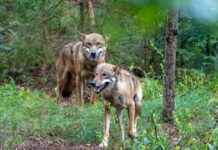Hunters in the Grisons region have shot wolves for the first time during the high hunt season. According to Arno Puorger from the Office for Hunting and Fishing, 14 wolves have been culled by wildlife officers since the regulation period began on September 1st. Puorger, the person in charge of large carnivores, expressed satisfaction with the inclusion of hunting in wolf management.
In order to obtain a license to shoot wolves, licensed hunters must attend an instructional evening. The interest in this requirement has been high, with 2700 out of 5200 hunters in the Grisons region having completed the course so far. However, they are only allowed to target wolves in areas where entire packs are being shot.
The federal government has approved 55 to 60 wolf culls for the regulation period, which lasts until the end of January. The total number of wolves in the region will only be announced in winter, as counting wolves is a complex process. According to Puorger, wolf management is not based on the total number of wolves but rather on the number of packs and their behavior.
The Canton of Grisons aims to completely remove three out of the eleven wolf packs and reduce the size of six packs by shooting young animals to make them more wary. Two packs will not be regulated. While hunting wolves is not entirely new in Graubünden, they were first included in the special hunt in late autumn last year. However, no hunters were able to successfully shoot any of the large predators.
The decision to involve hunters in the management of wolf populations has sparked mixed reactions from the public. Some see it as a necessary step to control the wolf population and protect livestock, while others argue that wolves are an essential part of the ecosystem and should be left alone. The debate between conservationists, hunters, and farmers continues as the wolf population in the region remains a contentious issue.
The increase in wolf sightings and attacks on livestock has led to heightened tensions between different interest groups in the Grisons region. Farmers are concerned about the safety of their animals, while conservationists advocate for the protection of wolves as a vital part of the ecosystem. The role of hunters in managing the wolf population remains a topic of debate, with concerns about the impact of culling on the overall wolf population and ecosystem balance.
As the regulation period continues, it will be important to monitor the effects of wolf culls on the population dynamics and behavior of wolf packs in the Grisons region. Finding a balance between conservation efforts, livestock protection, and sustainable hunting practices will be crucial in ensuring the long-term coexistence of wolves and humans in the region.

















